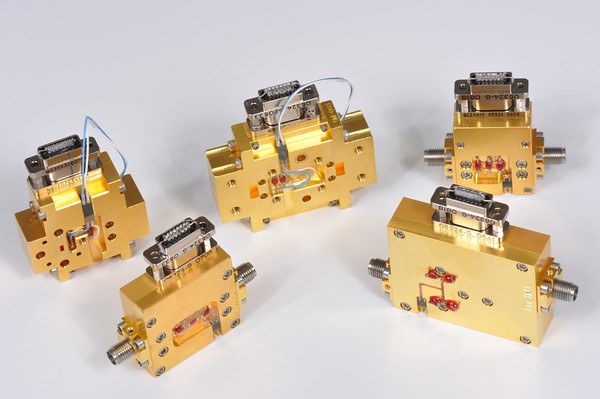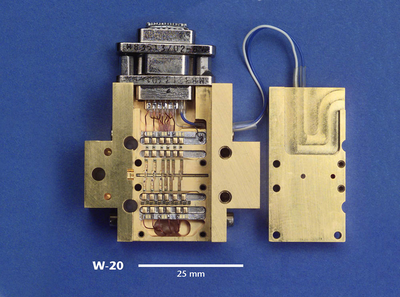一流产品,以专业铸造辉煌


Cryogenic Low Noise Amplifiers - Pushing the limits of low noise
低温低噪声放大器产品咨询:185 0219 3480.

Family of cryogenic LNAs (from L-band to W-band) developed and built for the VLA and GBT.
射电天文应用低温低噪声放大器
Program Overview
Cryogenic cooling of receivers to reduce their noise temperature is especially important in radio astronomy and in satellite and space communication. An antenna is “looking up “ into the sky and, in the absence of strong celestial sources (Sun, Moon, planets, Cassiopeia, Cygnus, Taurus, Virgo, Orion, and the galactic plane) in the antenna beam, “sees” a very cold sky: 2.725 K of the cosmic microwave background radiation modified by the presence of atmosphere. The antenna temperature is therefore typically one order of magnitude or more less than in terrestrial applications (300 K). Consequently, a reduction of receiver noise by cryogenic cooling offers a very effective way of improving radio astronomy system sensitivity.
Since 1980, the Central Development Laboratory (CDL) has been a world leader in the development and production of Low Noise Amplifiers (LNAs) used at cryogenic temperatures for radio astronomy and deep space communication. Over this period the improvements made in the noise temperature of amplifiers have been quite dramatic. For example, in 1980, a noise temperature of 25 K was reported for a narrow band amplifier at the frequency of 4.5 GHz; in 2003, noise temperatures of 2 K, 8 K and 35 K were reported for broadband amplifiers at 4 GHz, 30 GHz and 100 GHz, respectively, at physical temperatures of about 15 K. These improvements have been central to scientific advancements. CDL not only provided LNA’s for all the EVLA, VLBA, GBT and NA ALMA receivers but also provided LNAs and/or shared the designs, assembly, and testing techniques with a number of other radio astronomy projects. Most importantly these include Wilkinson Microwave Anisotropy Probe, ESA PLANCK spacecraft Low Frequency Instrument, Cosmic Background Imager, Degree Angular Scale Interferometer, Arcminute Microkelvin Imager, and NASA Deep Space Network, among others.
Historical Background:
In the early 1970s, ultra-low-noise receiving systems for deep space and radio astronomy employed mainly solid-state masers, cryogenically-cooled parametric amplifiers (or converters) and Schottky diode mixers. At the end of that decade, advances in Gallium Arsenide (GaAs) Field Effect Transistor (FET) technology made the noise performance of GaAs FET amplifiers competitive with the performance of parametric amplifiers. Additionally, a new mixing element, the Superconductor Insulator Superconductor (SIS) tunnel junction capable of almost quantum limited detection, was developed.
In the 1980s and 1990s, FET’s were gradually replaced by Heterostructure FETs (HFET), also known as High Electron Mobility Transistors (HEMT), of several different generations, first using AlGaAs/GaAs, then AlGaAs/InGaAs/GaA , and finally AlInAs/InGaAs/InP heterostructures. These last devices have become the technology of choice for low noise cryogenic amplifiers for frequencies up to W-band (3 mm). Quite recently a Silicon-Germanium (Si-Ge) Heterojunction Bipolar Transistors (HBTs) has been demonstrated to offer a competitive noise performance at cryogenic temperatures at low microwave frequencies (less ten 4 GHz). Such devices can be used in lower frequency amplifiers as well as in IF amplifiers for SIS mm-wave receivers, offering, in principle, an order of magnitude lower 1/f-like gain fluctuations, improving continuum radiometer sensitivity as compared with HFETs. SiGe HBTs are, however, not expected to compete with InP HFETs at higher microwave frequencies up to approximately 120 GHz. At these frequencies commonly known as W-band HFET receivers now compete in noise performance with SIS/HFET mixer-preamplifiers. At frequencies above 120 GHz up to about 1 THz, SIS mixers demonstrate the best noise performance. Above 1 THz, cooled Schottky diode mixers and HEB mixers provide the lowest noise temperatures.
For more detailed historical review of the cryogenic amplifier work done at CDL please see: M. W. Pospieszalski, "Extremely Low-Noise Amplification with Cryogenic FET's and HFET's: 1970-2004," Microwave Magazine, vol. 6, no. 3, pp. 62-75, Sept. 2005.
Current Activities:
The research work and development work at CDL is centered on three main areas:
1. Design, development and production of amplifiers for all NRAO radio telescopes in frequency range covering 200 MHz to 120 GHz.
2. General noise properties of noisy networks, especially HFETs and HBTs at cryogenic temperatures.
3. Radio astronomy receivers and radio meters employing HFETs and HBTs.

Inside of CDL W-band cryogenic LNA.
低温低噪声放大器型号参考 Caltech Models Reference
The Caltech Microwave Research Group previously manufactured over 1000 amplifiers for other research centers. Revenue from these sales was used to support research at our lab. The noise specified below is measured at 20K amplifier case temperature.
SiGe HBT
CITLF1, 0.001 to 1.5 GHz, Tn < 9K
CITLF2, 0.01 to 2 GHz, Tn < 4K
CITLF3, 0.01 to 2 GHz, Tn = 4.5 +/- 1K
CITLF4, 0.5 to 4 GHz, Tn < 8K
GaAs HEMT
CIT118 1 to 18 GHz, Tn < 7K
CIT416 4 to 16 GHz, Tn < 7K
CIT618 6 to 18 GHz, Tn < 7K
Cryogenic HEMT
CITCRYO1-12A-1 1 to 12 GHz, Tn < 8K
CITCRYO4-12A 4 to 12 GHz, Tn < 5K
CRYO1126 11 to 26 GHz, 14K < Tn <20K CRYO1126
Past Amplifier Group Accomplishments:
• A method of measurement of noise parameters at cryogenic temperatures (1986)
• A first formulation of noise parameters of isolators (1986)
• Development of AlGaAs/GaAs HFETs (with General Electric and JPL) and X-band amplifiers with record-breaking noise performance for the Voyager/Neptune Project (1988) –with Sandy Weinreb
• Development of a new noise model of a FET or HFET, now known in literature as the Pospieszalski noise model (1989)
• Development of 15 GHz amplifiers and ground based receivers for Space VLBI Observations Using an Antenna on a TDRSS Satellite (1989) - with Sandy Weinreb
• First cryogenic evaluation of pseudomorphic HFETs (PHFET) (1990) - with Sandy Weinreb
• First cryogenic evaluation of AlInAs/GaInAs/InP HFETs at cryogenic temperatures (1993) establishing the lowest ever noise temperatures for three terminal devices
• First demonstration of an integrated SIS mixer with HFET amplifiers (1996) – with Steve Padin
• Design of amplifiers and co-design of radiometers for the Wilkinson Microwave Anisotropy Probe (WMAP) (1996-1999) –with Edward Wollack
• Design of amplifiers for Degree Angular Scale Interferometer (DASI) (1997), Very Small Array (VSA) (1997), and Cosmic Background Imager (1997, 2002)
• Development of 4-12 GHz IF amplifiers for ALMA (2000) – with Gene Lauria
• Collaboration with Jodrell Bank on the development of Ka- and Q-band amplifiers for Planck Satellite Low Frequency Instrument (2003-2004)
• Design and production of all amplifiers for new EVLA and GBT receivers covering different bands in 200 MHz to 115 GHz frequency range (2002 -2010)
• Establishment of certain allowable values of noise parameters for all microwave transistors (2010)
Papers

扫一扫
关注我们







